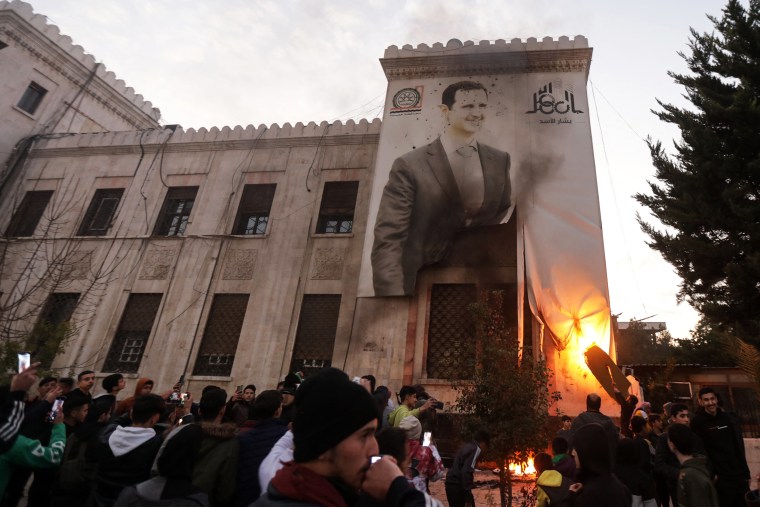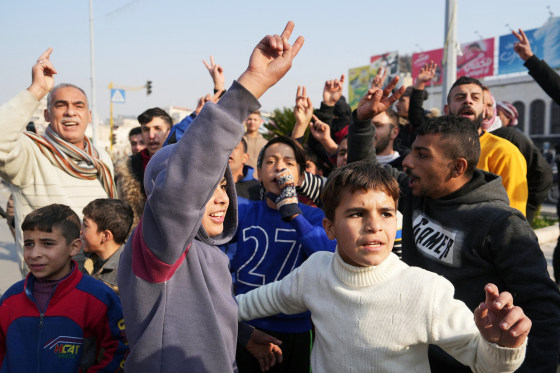Thousands of people have fled the Syrian city of Homs as rebel fighters pushed further south with their rapid assault on government forces, a leading monitoring group said.
If the strategically important municipality were to fall, it would leave three of the country’s five largest cities in the hands of the forces led by the militant group Hayat Tahrir al-Sham (HTS) and no major cities between rebel forces and the Syrian capital of Damascus.
In less than two weeks they have already captured the city of Aleppo in the north, as well as the central city of Hama — where government forces were forced out Thursday.
“Our forces continue to advance towards the city of Homs at a steady pace, thanks to God, after the arrival of convoys carrying hundreds of displaced people from Homs to deter Assad’s aggression against their city,” said Hassan Abdul-Ghani, senior commander of the HTS-led forces on Friday in a post on X.
While Hama was a more symbolic victory for the HTS-led insurgents, taking Homs would send a more practical message, said Neil Quilliam, an associate fellow with the MENA Programme at Chatham House, a London-based think tank.
Homs “is a stepping stone to Damascus and what comes next,” he told NBC News on Friday. “It would be passing through a threshold that suggests to the [Syrian] forces and all Syrians that HTS and those fighting forces with it are about to bear down on the capital and sweep away the regime.”
With his forces nearing, thousands of people had fled towards western coastal regions, a stronghold of the government where fighting has remained less fierce than in other parts of the country, the Syrian Observatory for Human Rights said Friday.
Various reports from around the country also suggested that the fall of Aleppo and Hama, as well other cities such as Idlib and numerous rural settlements, has significantly strained Assad’s forces as fighting between government troops and various rebel groups raged around the country.
Pro-Assad soldiers were also battling Kurdish forces who seized government positions in eastern Syria near the cities of Raqqa and Deir Ez-Zour, the Observatory said.

To the south of the country, state media quoted Jordan's interior ministry as saying that it was closing its Jaber border crossing to all outgoing traffic “due to the security conditions surrounding southern Syria.”
HTS grew out of the former Al Qaeda affiliate Jabhat al-Nusra and is designated as a terrorist organization by the United States and the United Nations. It’s one of several competing forces in Syria fighting to bring down the Assad regime that, since the beginning of the country’s civil war almost 14 years ago, has killed hundreds of thousands of Syrians.
The civil war died down in 2020 after a ceasefire, but has erupted again in recent days when rebels took Aleppo in a lightning attack.
Part of the foundation for the success of HTS and its allies has been laid over the past four years, with the group investing in professionalizing its forces and buying materiel such as drones, analysts say.
“The expansion of units... along with large-scale indigenous rocket and missile production -- has created a force that Assad’s regime has seriously struggled to defend against, let alone outmaneuver,” said Charles Lister, director of the Syria program at the Middle East Institute, a Washington-based think tank in a post on X.
The group has sought to strengthen its diplomatic links too, opening channels of communication with organizations and civilians traditionally hostile to it, Lister said.

HTS has negotiated with Shia and Sunni leaders, Kurdish groups and with regime military commanders, “most resulting in peaceful takeovers, safe exits & some [publicly unacknowledged] regime defections,” Lister said.
While some might dismiss that shift in messaging as superficial, “first impressions could count for a lot in defining what comes next,” he added.
While some reports suggested that HTS-led forces were as little as six miles away from northern Homs, the Syrian defense ministry said in a post on Facebook that its units were targeting the rebels to the north and south of Hama with “artillery fires, missiles and Syrian-Russian joint military aircraft.”
Inside the city, video footage showed a statue of President Assad’s father and predecessor Hafez being torn down.
NBC News was unable to independently confirm claims by either side — government repression of media and a rapidly shifting map of make independent journalism almost impossible in Syria where the Assad regime has long received aerial and military backing from Moscow.
Heavy Russian-led bombing of civilian infrastructure was a key and bloody feature of the Syrian civil war in the years leading to the 2020 ceasefire.
Members of the insurgent forces also told NBC News that bombing by Russian aircraft overnight also focused on the Rustan bridge along the main route to Homs, presumably in a bid to slow the rebels' advance.
Meanwhile, the Israeli Air Force struck border crossings, roads and other infrastructure on Syria’s border with Lebanon early Friday, according to local Syrian and Lebanese media.
Israel's military also said in a statement that its air force struck “weapon-smuggling routes and terror infrastructure sites located near the Syrian regime’s crossings at the Syrian-Lebanese border. These routes were used by Hezbollah to smuggle weapons.”
Iran-backed Lebanese militant group Hezbollah, as well as Tehran itself, have long been backers of the Assad regime and the re-eruption of the Syrian civil war follows a ceasefire between Israel and Hezbollah, after months of fighting degraded the militia.
With those two backers now compromised, what's next for the Assad regime depends on decisions within the Kremlin, Neil Quilliam told NBC News.
“It all comes down to Russia and its calculations as to whether it has the capacity and the will to step in,” Quilliam said. “Its interests are deeply embedded in Syria so it seems strange that it would not intervene but it’s not clear that it’s willing to do so. That would mean the end of the regime.”
In a post on Facebook, Russia's embassy in Damascus told its citizens that “due to the difficult military-political situation in Syria, the Embassy... reminds Russian citizens... of the possibility of leaving the country on commercial flights through active airports.”

